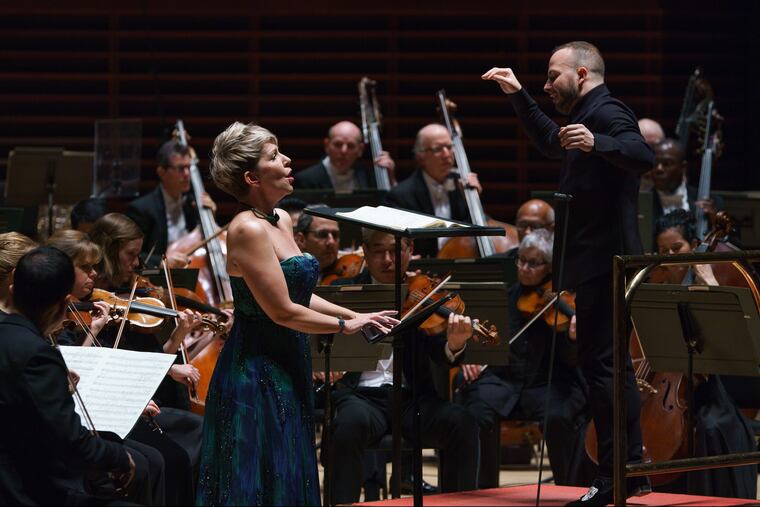Joyce DiDonato and Yannick Nézet-Séguin pair their star power at Philadelphia Orchestra
DiDonato sang Chausson with shimmering intensity. Nézet-Séguin brought out intriguing dark undertones.

Music is the ultimate non-visual art, though you might have had a hard time convincing Philadelphia Orchestra audiences of that Thursday in a program that was out to describe oceans, fountains, and nonexistent animals.
The banner attraction was star mezzo-soprano Joyce DiDonato singing Chausson's Poeme de amour et la mer, and music director Yannick Nézet-Séguin found conceptual offshoots from that piece, both obvious (Respighi's Fountains of Rome) and up to the -minute (Mason Bates' Anthology of Fantastic Zoology).
Though the Chausson Poeme doesn't always reach American audiences, the piece made the strongest impression of the evening, starting with DiDonato, who took the amorphous text to heart and gave it interpretive intensity that reminded you she just came from playing the tragic Dido in Berlioz's Les Troyens at the Vienna State Opera.
Her well-projected voice was in good shape with the trademark shimmering vibrato that gives vocal nerds happy flashbacks to the great 1950s Chausson interpreter Irma Kolassi.
DiDonato found darker-than-usual colors in her lower range, but as the piece conjured up the spirits of lost loved ones, her voice grew pale and vibratoless — to great effect — without losing communicative vibrancy.
From his end, Nézet-Séguin took the piece well beyond its typical orchestral mellifluousness in a microscopic tour of the orchestration — with the atmospheric tone painting mixed with dark undertones, often expressed in quiet timpani that felt more ominous than usual. My tastes are such that I wouldn't want sound painting any more specific than this.
Respighi's orchestral tone poems, in contrast, are pictorial snapshots that leave little room for a poetic dimension, like a film score without a film. But Fountains of Rome (which concludes with Chaussonesque melancholy) had Nézet-Séguin delivering meticulously molded orchestra sonorities that spoke expressive volumes and kept you from listening on only a descriptive level.
Bates' Anthology, written in 2014, shows the 41-year-old composer testing his limits and discovering he maybe doesn't have any. The wondrous animals in these 11 miniature portraits — with literary nudging from Jorge Luis Borges' Anthology of Fantastic Zoology — are the anything-but-literal fruits of his fabulous imagination.
Few pieces this side of Jennifer Higdon's Concerto for Orchestra have provocative instrument pairings batting around infectious musical ideas amid giddy but purposeful rhythms. Full-orchestra moments use high winds to creating a chrome-plated sheen.
Coordination challenges are immense with music that goes in so many directions so quickly, though the Philadelphia Orchestra navigated seamlessly. This piece usually leaves me wanting more, but this performance felt like quite enough, as Nézet-Séguin sometimes probed for depths that are perhaps not discoverable.
Where did the Act I prelude to Wagner's opera Lohengrin fit in?
While Chausson used outdoor imagery to describe an inner emotional state, Wagner used similar string writings to explore more profound states without help from natural phenomena. It was an ideal example of a conceptually based concert that doesn't narrow the listener's focus but opens more doors.
Nézet-Séguin found marvelous details amid Wagner's single, slow-motion musical gesture.
The program is repeated at 2 p.m. Friday, Nov. 9, and 8 p.m. Saturday, Nov. 10, at the Kimmel Center. Tickets: $44 -$158. Information: 215-893-1999 or philorch.org.